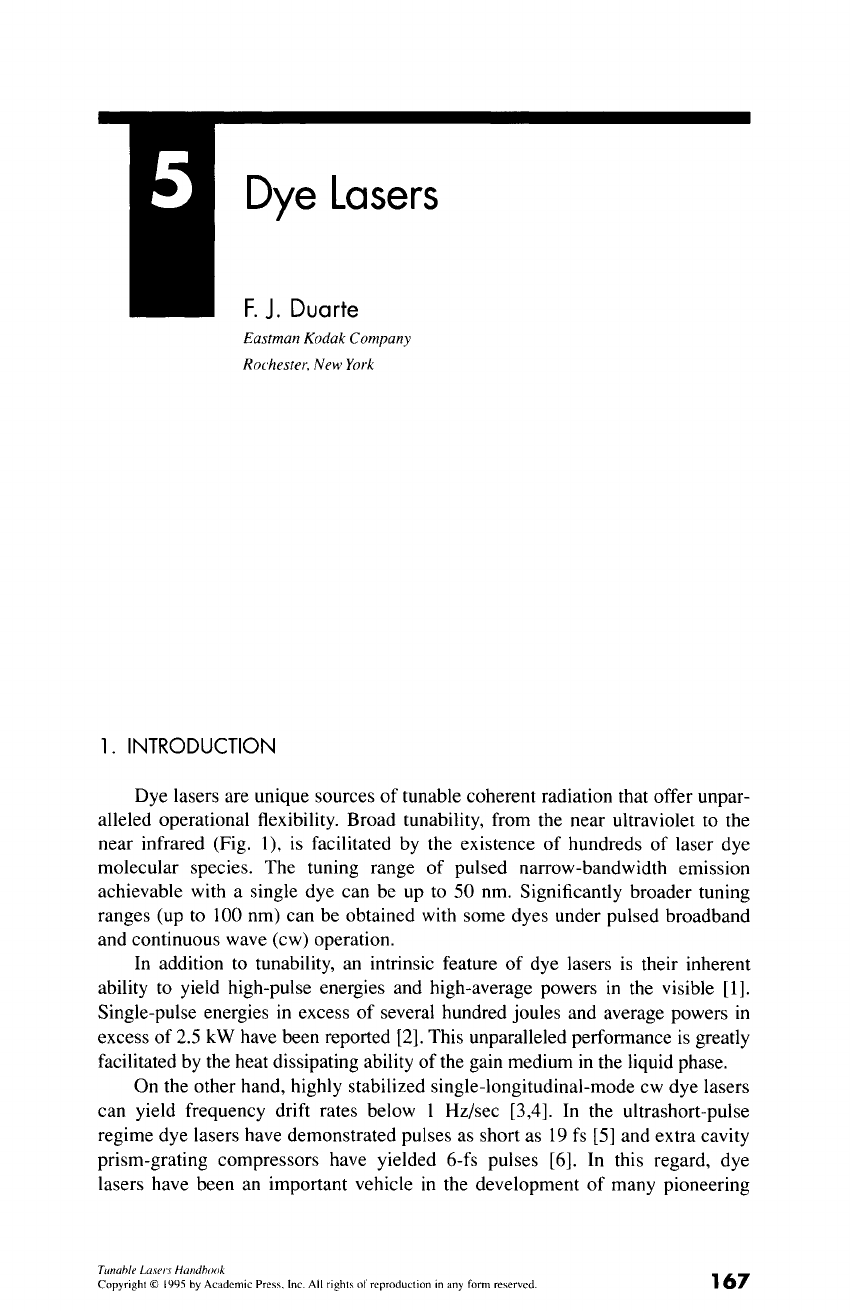
Dye Lasers
F. J. Duarte
Eastman Kodak Company
Rochester, New York
1. INTRODUCTION
Dye lasers are unique sources of tunable coherent radiation that offer unpar-
alleled operational flexibility. Broad tunability, from the near ultraviolet to the
near infrared (Fig. 1), is facilitated by the existence of hundreds of laser dye
molecular species. The tuning range of pulsed narrow-bandwidth emission
achievable with a single dye can be up to 50 nm. Significantly broader tuning
ranges (up to 100 nm) can be obtained with some dyes under pulsed broadband
and continuous wave (cw) operation.
In addition to tunability, an intrinsic feature of dye lasers is their inherent
ability to yield high-pulse energies and high-average powers in the visible [1].
Single-pulse energies in excess of several hundred joules and average powers in
excess of 2.5 kW have been reported [2]. This unparalleled performance is greatly
facilitated by the heat dissipating ability of the gain medium in the liquid phase.
On the other hand, highly stabilized single-longitudinal-mode cw dye lasers
can yield frequency drift rates below 1 Hz/sec [3,4]. In the ultrashort-pulse
regime dye lasers have demonstrated pulses as short as 19 fs [5] and extra cavity
prism-grating compressors have yielded 6-fs pulses [6]. In this regard, dye
lasers have been an important vehicle in the development of many pioneering
Tunable Lasers Handbook
Copyright 9 1995 by Academic Press, Inc. All rights of reproduction in any form reserved.
167

168 F.J. Duarte
Cyanines
Merocyanines
Xanthenes
Coumarins
Stilbenes
Oligophenylenes
Oxadiazoles
FIGURE 1
400 5()0 600 700 800 g00 1000 11 ~)0
Emission Wavelength (nm)
Approximate wavelength coverage achieved with different classes of laser dye molecules.
techniques that have now found wide applicability in lasers in general. Impor-
tant contributions to the laser field first demonstrated in dye lasers include fre-
quency stabilization techniques, pulse compression techniques, dispersive oscil-
lator configurations, and numerous cavity and resonator innovations.
Although dye molecules have been demonstrated to lase in the three states
of matter, it is in the liquid phase that dye lasers have made their most signifi-
cant impact. Recently, however, there has been a resurgence of work in solid-
state dye lasers. Hence a section of this chapter is especially devoted to this
topic.
This chapter is intended to provide an expeditious guide to the performance
and basic features of dye lasers. For an in-depth approach to the subject, the
reader should consult the references provided in the various sections and the fol-
lowing books:
High Power Dye Lasers
[1 ],
Dye Laser Principles
[7],
Dye Lasers
[8], and
Selected Papers on Dye Lasers
[9]. These works should also be con-
suited for a historical perspective on the subject.
1.1 The Molecular Gain Media
Laser dye molecules are large, with atomic weights in the 175- to 1000-amu
range (see the Appendix at the end of this chapter). These molecules exhibit a
wide absorption spectrum with broad and strong absorption maxima correspond-
ing to
So---~S n
electronic transitions (Fig. 2). Here, dye molecules are considered
simply from an energetic perspective with an excitation dynamics involving sev-
eral energy levels. A feature of dye laser molecules is that each electronic state
contains a multitude of overlapping vibrational-rotational levels. This plethora of
closely lying vibrational levels gives origin to the broadband gain and tunability
features that are so characteristic of dye lasers.
Get Tunable Lasers Handbook now with the O’Reilly learning platform.
O’Reilly members experience books, live events, courses curated by job role, and more from O’Reilly and nearly 200 top publishers.

